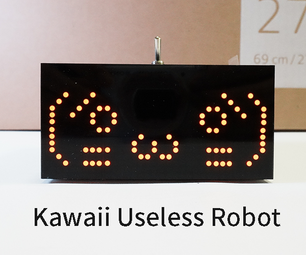Introduction: MeArm - Build a Small Hackable Robot Arm V0.3
This instructable is only for the MeArm v0.3. For the v0.4 see this one! For the latest MeArm checkout our website.
The MeArm is a small "Hackable" Robot Arm. It's an Open Source project by Benjamin Gray and Jack Howard. We set out to build a very low cost and fun to use Robot Arm. Our design brief was to keep the parts count to a small number of cheap parts.
- 4 hobby servos
- 3mm Machine Screws (M3 Fixings)
- No more than an A4 sheet of Acrylic
We've focused on the mechanical side up until now and it's still very much a work in progress. This instructable will concentrate on building the MeArm.
Using 4 potentiometers and very simple code this is an example of the kit in action.
Using some more advanced Inverse Kinematics Code, provided by Bob Stone and Nick Moriarty of York Hackspace (that's the old York - famous for the Grand Old Duke) things get really interesting.
Step 1: Gather Your Parts!
- MeArm v0.3 (Current Version)
- 4 Hobby Servos (9g Type)
- 3mm Machine Screws (M3 Fixings)
The M3 fixings you'll need are:
- 20mm x 4
- 10mm x 2
- 12 mm x 10
- 8mm x 13
- 6mm x 11
- Nuts x 14
Tools needed
- Screw Driver
Step 2: Build the Base
We're using a wooden version of the MeArm here. If you cut yours with wood note that the self tapping feature we've used to save on hardware doesn't work so well, but you can make up for that with longer screws and more nuts.
Take the four 20mm screws and four nuts. Insert the screws from the rear of the board and screw the nuts on about half way down. Hold the square part so the holes are in line with the screws and screw the ends into the holes until they're flush with the top of the square board. Once you've done this for all four screws then you can tighten the nuts to the base board.
Add sticky feet to the corners of the base so the screws don't scratch the surface you're working on.
Step 3: First Servo!
The method used here will also be used to attach two more servos a bit later. What we're doing is putting a collar around the base of the servo, note the notch on one side of the collar, that's so your control wires don't get pinched. Use two 8mm screws from the underside of the servo collar and screw them into the square part you just attached to the base board. The screws should self tap until approximately level with the square board. Don't over tighten as you might snap the collar. In acrylic this self tapping works well. In wood not so much...
We'll worry about the orientation of the servo later as we're not attaching it to the next part just yet.
Step 4: Building the Waist
Now we're going to add the central part. This uses another method we're going to use again. From the underside of the board insert two 12mm screws and screw on two nuts so they are just on. Take a close look at the pictures on this step. The hole on the top of this next piece should be at what we're going to consider the front and the the holes you've just put through the last piece should be on the left hand side.
Line up the notches in the central part and screw the nuts to tighten it to the base part. It can come out of alignment here so take a bit of care. Thinking about it we should probably add a notch if we rotated the placement of the horns 90 degrees and removed the fixing placement on the base. Apologies for making notes as I go but as mentioned this is a work in progress and should serve as the build for the v0.3!
Now onto the first part of the Bicep. This should go on the left with the hole towards the middle of the piece closest to the bottom. Use a 6mm screw inserted from the right, through the central part to self tap into the bicep part. Should really number these! Tighten enough to allow freeish movement of the parts with minimal wiggle.
Step 5: Building the Left Shoulder
Add the collar to the servo as earlier, and insert from the outside using the two 12mm screws.
Attach the small arm to the single servo horn using the method from before. This time we're going to attach it. Look at the images below. These should be the far ends of your servos movement and it should rotate away from the holes on the base.
Step 6: Attach Left Shoulder to Waist
Now push on the assembled left shoulder. In v0.3 there are three fixings to screw in but I think we'll probably lose the bottom one and make some improvements to the base plate of the waist.
Now that's attached we're going for some easy wins. Attach the parts shown below with 6mm fixings to gain a controllable forearm! Grab a 12mm screw and nut and add the central part of the bicep.
Step 7: Right Arm Construction
Step 8: Add Remaining Arm Parts!
Grab the two 10mm screws for this.
You'll want the triangle part on the outside, the remaining forearm length in the middle, all attached to the bicep. The forearm is different from the other two long bits you have left which should be identical.
Secure the back of the triangle with a spacer the last 10mm screw and one of those two identical parts. The other end of that part will attach to the back of the right shoulder with a 6mm screw.
Now lets build that gripper.
Step 9: Gripper!!
If you find yourself building this part and thinking "my that is clever" that was all Jack Howard. If anything needs more detail please let me know!
Step 10: Attach the Gripper and Fix to Base
Next you'll want to take the whole construction and add it to the base we made in part one. Use the screw that came with the servo to secure the base.
That's the mechanical part done!
Step 11: Stand Back, Admire, Think About Controlling It
Now it's finished you'll want to control it. One of the simplest ways is with an Arduino and four potentiometers.
We have a simple sketch on GitHub to do just that.
With this sketch manual control is fairly easy and you can get started with coding or just playing, which is where the project is at the moment
Please let us know what you think!

Second Prize in the
Robot Contest

Participated in the
Full Spectrum Laser Contest

Participated in the
Arduino Contest











